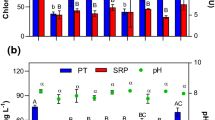Abstract
Study on the coagulation of four species of red tide organisms (Nitzschia pungens, Skeletonema costatum, Prorocentrum minimum and Noctiluca scintillans) with montmorillonite, and the effect of montmorillonite pretreatment on the coagulation shows that the capability for montmorillonite to coagulate with them is in the order:N. pungens > S. costatum > P. minimum > N. scintillans. The coagulation is discussed from the aspects of the structure, shape, size, movement, habit, etc. of different species and the results are explained theoretically. The experimental results also indicate that the treatment of montmorillonite with acid can enhance its coagulating capability. This is due to the fact that Al(OH2) +36 , exchanged from the clay lattice by hydrogen ion H+, forms hydroxy-aluminum polymers on the surface of the montmorillonite. The hydroxy-aluminum polymers positively charge and increase the positive characteristic of the clay surface, and also serves as a bridge between adjacent surfaces of particles. These two functions enhance the montmorillonite's capability for coagulating with the organism cells.
Similar content being viewed by others
References
Brown, G. and Newman, A. C., 1973. The reactions of soluble aluminium with montmorillonite.J. Soil Sci. 24: 339–354.
Geissler, U., 1958. Das membranpotential einiger diatomeen und seine bedeutung fur die lebende kieselalgenzelle.Mikroskopie 13: 145–172.
Guillard, R. R. L. and Ryther, J. H., 1962. Studies of marine planktonic diatoms.Canadian J. Microbiology 8: 229–239.
Harper, M. A., 1969. Movement and migration of diatoms on sand grains.Br. Phycol. J. 4: 97–103.
Hellebust, J. A., 1967. Excretion of organic compounds by cultured and natural populations of marine phytophankton.In “Estuaries” (G. H. Lauff ed.), Am. Assoc. Adv. Sci., Washington, D. C., pp. 361.
Lewin, J. C., 1961. The dissolution of silica from diatom walls.Geochim. et Cosmochim. Acta 21: 182–198.
Lewin, J. C., 1955. The capsule of the diatomNavicula pollicalosa.J. Gen. Microbiol. 13: 162–169.
Low, P. F., 1955. The role of aluminium in the titration of bentonite.Soil Sci. Soc. Am. Proc. 19: 135.
Schwertmann, U. and jackson, M. L., 1963. Hydrogen-aluminium clays: a third buffer range appearing in potentiometric titration.Science 139: 1052–1053.
Werner, D., 1977. The Biology of Diatoms, Blackwell Scientific Publications, Oxford London Rdinburgh Melbourne, p. 141.
Yu Zhiming, Zou Jingzhong and Ma Xinian, 1994. Application of clays to removal of red tide organism, Part I. coagulation of clays for red tide organisms,Chinese.J. Oceanol. Limnol. 12(2): 193–200.
Author information
Authors and Affiliations
Additional information
Contribution No. 2228 from the Institute of Oceanology, Chinese Academy of Sciences.
The thesis is supported by the Chinese Postdoctoral Fund, Natural Science Fund of Shandong Province No. 93E0157 and State Major Basic Research Project (PD-B6-7-2).
Rights and permissions
About this article
Cite this article
Zhi-ming, Y., Jing-zhong, Z. & Xi-nian, M. Application of clays to removal of red tide organisms II. Coagulation of different species of red tide organisms with montmorillonite and effect of clay pretreatment. Chin. J. Ocean. Limnol. 12, 316–324 (1994). https://doi.org/10.1007/BF02850491
Received:
Issue Date:
DOI: https://doi.org/10.1007/BF02850491




